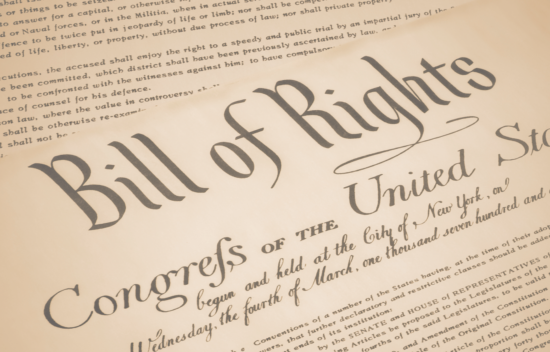
Woodrow Wilson and the Espionage Act
85 min- Was the Espionage Act of 1917, signed into law by President Woodrow Wilson, a constitutional war measure?
Students will:
- Understand Woodrow Wilson’s fear of the “poison of disloyalty” in the US.
- Understand challenges to civil liberties in the US before and during World War I.
- Assess constitutional limits on free speech and whether they change during wartime.
- Evaluate the constitutionality of the 1917 Espionage Act.
- Handout A: Woodrow Wilson and the Espionage Act
- Handout B: Wilson’s Request
- Handout C: The Espionage Act (1917)
- Handout D: “No Conscription” Newsletter
- Handout E: The “Trial of Emma Goldman”
To create a context for this lesson, have students complete Constitutional Connection: War and the Constitution.
Have students read Handout A: Woodrow Wilson and the Espionage Act and answer the questions.
DAY ONE ACTIVITY [20 MINUTES]
Have a student assume the persona of Wilson and read the excerpt from his 1915 State of the Union Address on Handout B: Wilson’s Request. Encourage the student playing Wilson to read dramatically.
Tell students that recently, one modern member of Congress said about this speech, “[Wilson’s] plea … astonishes still, as much for its passion as for what it proposes… No president had ever spoken like that before; none has since.” How does Wilson’s speech sound to modern ears? Do students find it “astonishing” or unique? Why or why not?
Distribute Handout C: The Espionage Act (1917). Read the law together and clarify any questions students have.
DAY TWO ACTIVITY [30 MINUTES]
Arrange the classroom with a desk for a “witness stand,” an open area for attorneys to stand, and enough chairs for judges.
Using their guide on Handout E, have students present the trial.
At the conclusion of the trial, you may wish to distribute or project the 1918 New York Times story found at timesmachine.nytimes.com/timesmachine/1918/01/15/96864247.pdf?pdf_redirect=true&ip=0.
DAY ONE WRAP-UP [15 MINUTES]
Distribute Handout D: “No Conscription” Newsletter and allow students to skim over it. Ask the class: What is this newsletter asking you to do? Did the author of the “No Conscription” newsletter violate the Espionage Act?
Tell students that next class they will put the newsletter’s author, Emma Goldman, on trial. Distribute Handout E: The “Trial of Emma Goldman.” Let students know the scrip contains some direct quotes but is a fictional dramatization.
Assign the following roles: Narrator, Emma Goldman, Lead Counsel for Miss Goldman, US Attorney, Leon Frank Czolgosz, President Woodrow Wilson, and three to five judges.
Let students know they can stick to the script or add to it as appropriate. They should not omit any parts, though.
Students who do not play a role may serve as “assistant counsel” to the attorneys on either side, as “law clerks” for the judges, or in other supporting roles of your creation (e.g. Theodore Roosevelt; J. Edgar Hoover; congressional supporters of the Act; World War I soldiers; Kate Richards O’Hare, Rose Pastor Stokes.).
Encourage students to file “amicus briefs” (e.g. short, historically accurate statements in support of either the prosecution or the defense).
DAY TWO WRAP UP [20 MINUTES]
Debrief the class, asking students:
- Did Emma Goldman break the law?
- Was the law she was accused of breaking, the Espionage Act, constitutional?
- Was the Supreme Court correct to uphold her conviction under the Espionage Act?
Have students explain whether they believe the Supreme Court was correct to uphold the constitutionality of the Espionage Act and Emma Goldman’s conviction. They can express their view by: writing one paragraph; creating a poster or flyer; or drawing a political cartoon.
Ask students to respond to the following prompt with a short essay: What if the Espionage Act were passed today? Would it be well received? What similarities and differences apply?
Have students research the release of the 1917 film “Spirit of 76” and the subsequent arrest, conviction and jailing of its producer, Robert Goldstein. Why was Goldstein arrested? Was his conviction just? Why or why not?
Have students learn more about the trial of Italian anarchists Sacco and Vanzetti. Students can begin their research at www.britannica.com/biography/Sacco-and-Vanzetti.
The challenge to civil liberties in the US did not end with the conclusion of World War I. More than 4,000 suspected communists and anarchists were arrested across the US from 1918-1921 in what came to be known as the Palmer Raids. Have students research the Palmer Raids, along with violations of civil liberties during World War II, the Vietnam War, and the War on Terror. They should write a two- to three-page essay answering the question: Using history as a guide, do laws “excused on the plea of necessity in wartime” in fact tend to become the “fixed rule” once war is over?



